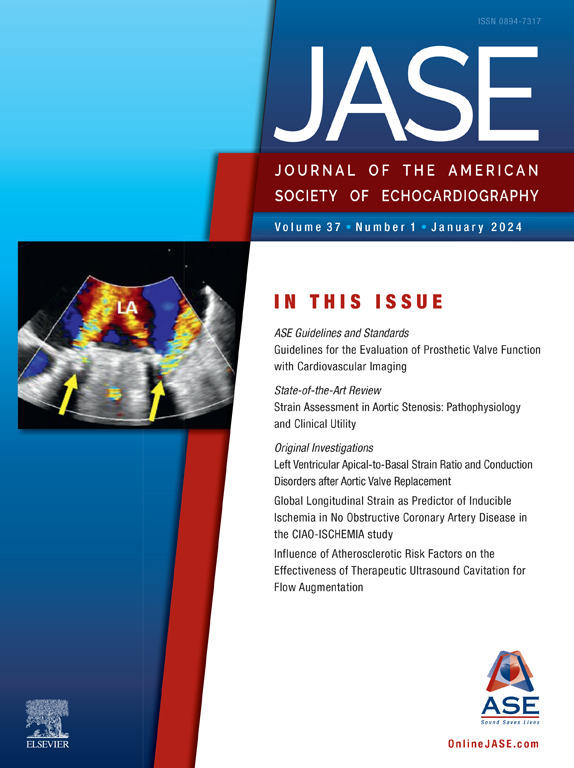尖部肥厚型心肌病患者左室心尖力学的临床意义。
IF 5.4
2区 医学
Q1 CARDIAC & CARDIOVASCULAR SYSTEMS
Journal of the American Society of Echocardiography
Pub Date : 2024-12-01
DOI:10.1016/j.echo.2024.08.016
引用次数: 0
摘要
背景:心尖肥厚型心肌病(ApHCM)是一种主要在左心室(LV)心尖处发生病理性肥厚的独特疾病。尽管先前的研究表明 ApHCM 存在心尖功能障碍,但尚未对心尖力学在疾病进展过程中的变化进行深入研究。方法:根据左心室心尖最大壁厚(AMWT)和肥厚程度将104例ApHCM患者分为3个亚型:相对型(AMWT结果为孤立的心尖肥厚)、孤立型(AMWT结果为孤立的心尖肥厚)、孤立型(AMWT结果为孤立的心尖肥厚)和孤立型(AMWT结果为孤立的心尖肥厚):即使在相对型 ApHCM 患者中,心尖纵向应变(LS)、周向应变(CS)和径向应变(RS)与对照组相比也明显受损(LS:-14.6±4.1% vs. -20.0±1.7%,p=0.001;CS:-19.6±2.5% vs. -25.6±3.7%,p=0.002;RS:26.6±7.4% vs. 35.6±11.1%,p=0.026),而心尖旋转和 LV 扭转保持不变。在心尖肥厚程度较高的患者(混合型和单纯型患者)中,心尖LS和RS的异常程度更高。此外,与相对型患者相比,心尖旋转明显减少。调整临床和心肌机械参数后,心尖旋转与 NYHA 分级≥ II(几率比=0.81,95% 置信区间[CI]:0.66-0.99,p=0.036)和综合结果(危险比=0.82,95% CI:0.73-0.91,p=0.001)独立相关:结论:相对型ApHCM表现出心尖功能障碍,但心尖旋转不明显,这在更广泛的表型中是异常的。左心室心尖力学与临床模式密切相关,心尖旋转与 NYHA 分级≥ II 和临床事件相关。本文章由计算机程序翻译,如有差异,请以英文原文为准。
Clinical Implications of Left Ventricular Apex Mechanics in Patients With Apical Hypertrophic Cardiomyopathy
Background
Apical hypertrophic cardiomyopathy (ApHCM) is a unique disease with pathologic hypertrophy mainly at the left ventricular (LV) apex. Although previous studies have indicated apical dysfunction in ApHCM, how apical mechanics change during disease progression has not been thoroughly examined. The aims of this study were to characterize the mechanics of the LV apex in patients with ApHCM at different disease stages and to explore the clinical significance of these alterations.
Methods
One hundred four patients with ApHCM were divided into three subtypes on the basis of LV apical maximum wall thickness (AMWT) and extent of hypertrophy: relative type (isolated apical hypertrophy with AMWT < 15 mm), pure type (isolated apical hypertrophy with AMWT ≥ 15 mm), and mixed type (both apical and midventricular hypertrophy with AMWT ≥ 15 mm). Two-dimensional speckle-tracking echocardiography was used to analyze LV segmental strain, global strain, and twist. Comparisons of these parameters were performed among ApHCM subtypes and 30 healthy control subjects. Logistic regression and Cox proportional-hazards regression analyses were used to explore associations between myocardial mechanics and clinical indicators. A composite outcome of new-onset atrial fibrillation, heart failure hospitalization, myectomy, and all-cause mortality was assessed.
Results
Even in relative ApHCM patients, apical longitudinal strain (LS), circumferential strain, and radial strain (RS) were significantly impaired compared with control subjects (LS: −14.6 ± 4.1% vs −20.0 ± 1.7% [P = .001]; circumferential strain: −19.6 ± 2.5% vs −25.6 ± 3.7% [P = .002]; RS: 26.6 ±7.4% vs 35.6 ± 11.1% [P = .026]), while apical rotation and LV twist remained unchanged. In patients with greater apical hypertrophy (mixed and pure patients), apical LS and RS were more abnormal. Moreover, apical rotation showed significant reductions compared with relative-type patients. After adjusting for clinical and myocardial mechanical parameters, apical rotation was independently associated with New York Heart Association functional class ≥ II (odds ratio, 0.81; 95% CI, 0.66-0.99; P = .036) and the composite outcome (hazard ratio, 0.82; 95% CI, 0.73-0.91; P = .001).
Conclusions
Relative ApHCM demonstrates apical dysfunction but sparing of apical rotation, which was abnormal in more extensive phenotypes. LV apex mechanics were closely related to clinical patterns, with apical rotation correlated with both New York Heart Association functional class ≥ II and clinical events.
求助全文
通过发布文献求助,成功后即可免费获取论文全文。
去求助
来源期刊
CiteScore
9.50
自引率
12.30%
发文量
257
审稿时长
66 days
期刊介绍:
The Journal of the American Society of Echocardiography(JASE) brings physicians and sonographers peer-reviewed original investigations and state-of-the-art review articles that cover conventional clinical applications of cardiovascular ultrasound, as well as newer techniques with emerging clinical applications. These include three-dimensional echocardiography, strain and strain rate methods for evaluating cardiac mechanics and interventional applications.

 求助内容:
求助内容: 应助结果提醒方式:
应助结果提醒方式:


